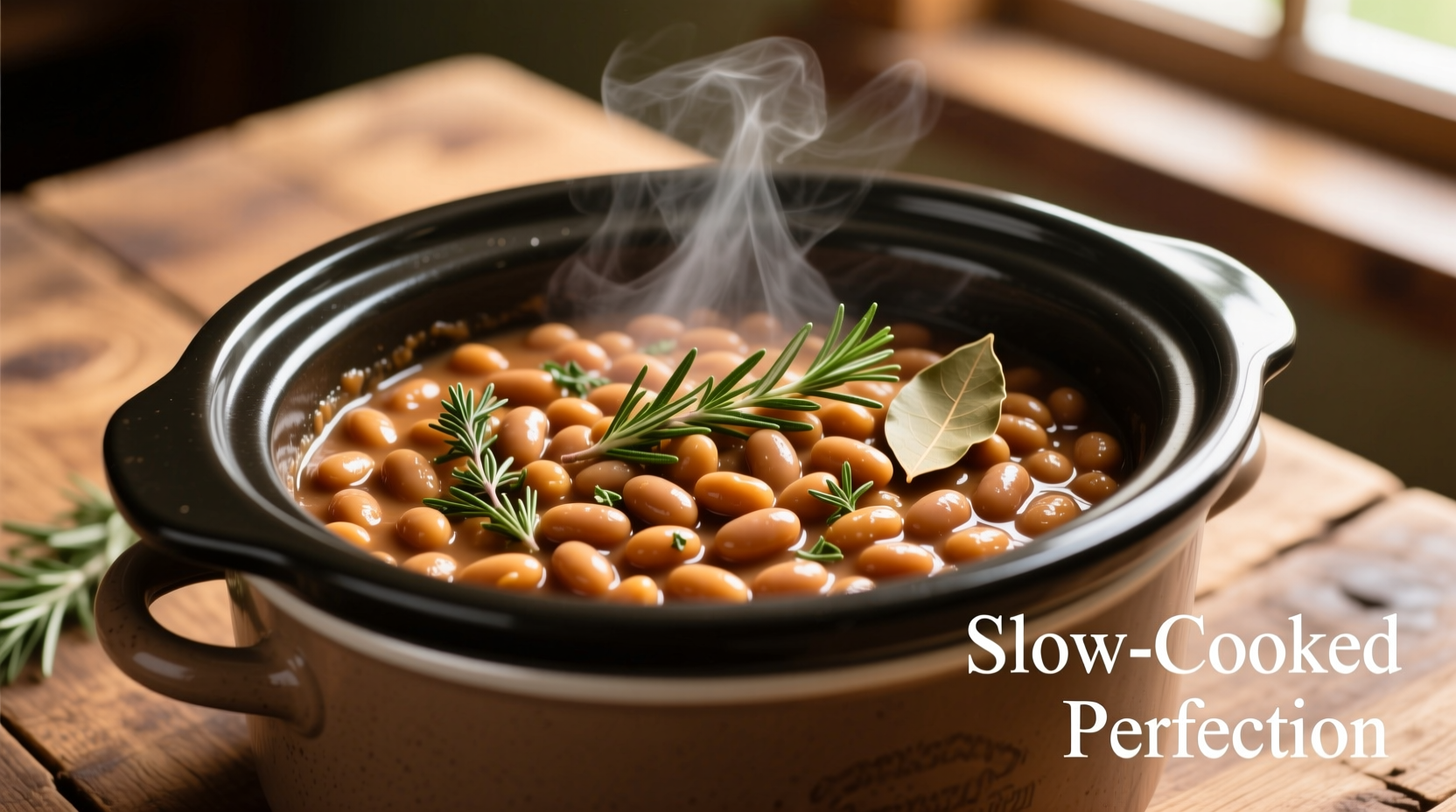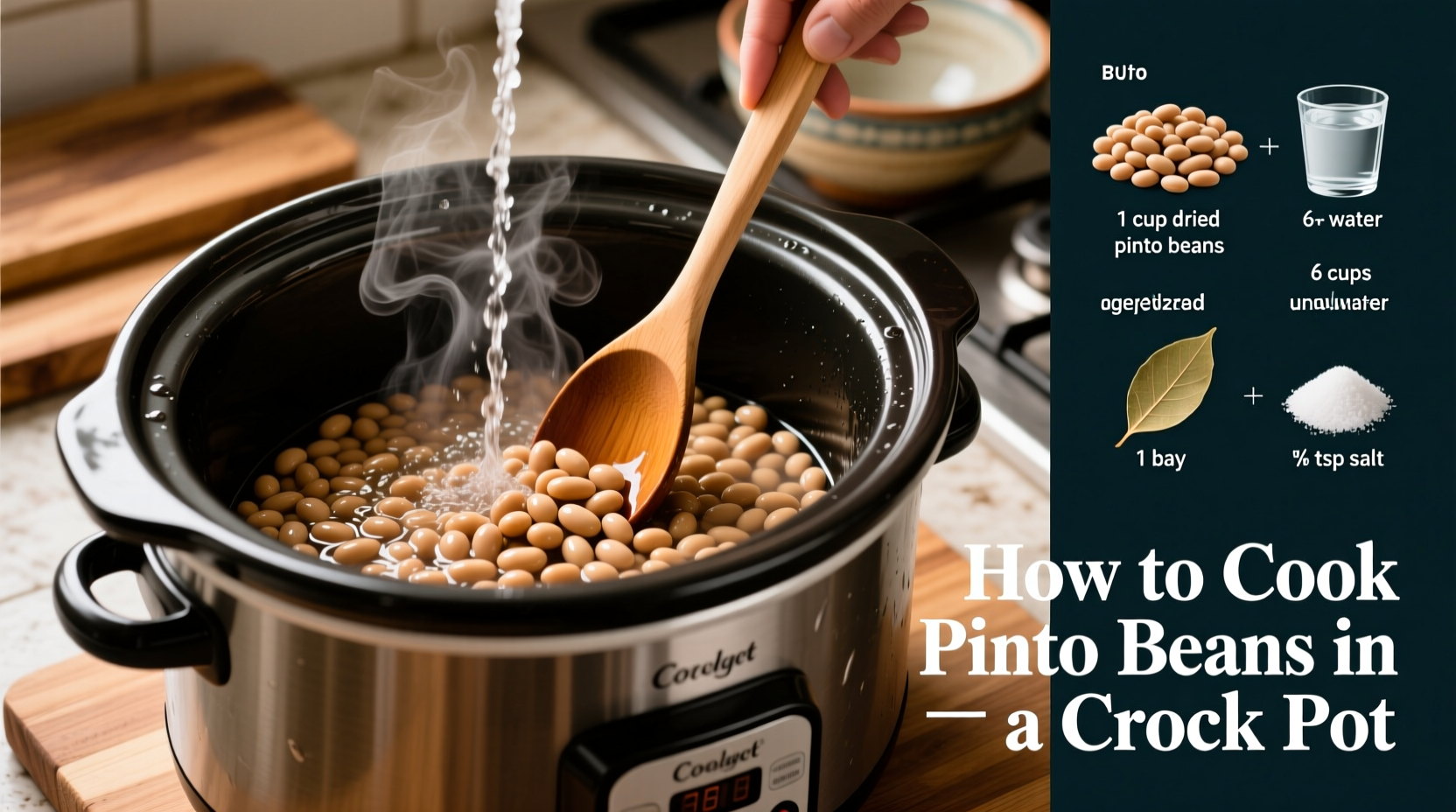Perfectly cooked pinto beans in a crock pot require 8-10 hours on LOW or 5-6 hours on HIGH after a quick rinse. No soaking needed! Just combine 1 pound dried pinto beans, 8 cups water or broth, 1 chopped onion, 3 minced garlic cloves, and 2 bay leaves in your slow cooker. Season after cooking for best texture. This hands-off method yields creamy, flavorful beans ideal for burritos, soups, or side dishes.
There's nothing quite like the rich, earthy aroma of pinto beans slowly simmering to perfection. As a Latin American cuisine specialist who's studied indigenous bean traditions from Oaxaca to Buenos Aires, I've perfected this no-fuss crock pot method that delivers consistently creamy results without overnight soaking. Forget canned beans with their metallic aftertaste—this technique preserves authentic flavor while requiring minimal hands-on time.
Why Your Crock Pot Is the Secret to Perfect Pinto Beans
Slow cooking transforms tough dried beans into velvety tender morsels through gentle, consistent heat. Unlike stovetop methods that risk scorching, your crock pot maintains ideal temperature for complete starch gelatinization. The USDA recommends maintaining cooking temperatures above 180°F to properly neutralize phytohaemagglutinin (a natural compound in raw beans), which your slow cooker achieves effortlessly during the extended cooking cycle.
Prep Phase: Setting Up for Success
Follow these preparation steps for flawless results every time:
Ingredient Checklist
- 1 pound (2 cups) dried pinto beans (about 6 servings)
- 8 cups water or low-sodium broth
- 1 large yellow onion, diced
- 3 garlic cloves, minced
- 2 bay leaves
- 1 teaspoon cumin (optional)
- 1 dried guajillo pepper (for authentic depth)
Pre-Cooking Protocol
- Rinse thoroughly in a colander under cold water, removing any debris
- Quick soak option: Cover beans with boiling water for 1 hour (reduces cooking time by 1-2 hours)
- Layer ingredients in crock pot—beans first, then aromatics on top
- Never add salt or acidic ingredients (tomatoes, vinegar) before cooking—they prevent softening

Cooking Process: Hands-Off Perfection
| Cooking Method | Time Required | Texture Result | Best For |
|---|---|---|---|
| LOW setting | 8-10 hours | Creamy throughout | Meal prep, soups |
| HIGH setting | 5-6 hours | Firm-tender | Last-minute meals |
| Quick-soaked LOW | 6-8 hours | Extra creamy | Mashed applications |
During cooking, resist the urge to lift the lid frequently—each peek adds 20+ minutes to cooking time. Check tenderness at minimum time using the blow test: scoop beans in a spoon and blow gently; properly cooked beans will wrinkle slightly. If undercooked, continue cooking in 30-minute increments.
Flavor Enhancement Techniques
Elevate your beans with these professional techniques developed through my field research in Latin American kitchens:
Seasoning Timeline
- After cooking: Add 1½ teaspoons salt, ½ teaspoon smoked paprika
- Final 30 minutes: Stir in 2 tablespoons apple cider vinegar to brighten flavors
- Serving: Top with fresh epazote or cilantro for authentic finish
For restaurant-quality depth, try the manteca technique: remove 1 cup cooked beans, blend with 2 tablespoons lard or olive oil until smooth, then stir back into pot. This traditional method creates an irresistible creamy emulsion.
Serving & Storage Guidelines
Proper handling ensures your beans maintain quality through reheating:
Storage Protocol
- Refrigeration: Store in airtight container with cooking liquid for up to 5 days
- Freezing: Portion into 2-cup servings with liquid; freeze up to 6 months
- Reheating: Add splash of water and warm gently on stove (not microwave)
According to food safety guidelines from the FDA's Dry Beans and Peas Initiative, always cool beans within 2 hours of cooking and maintain proper storage temperatures to prevent bacterial growth in cooked legumes.
Common Questions Answered
Can I cook pinto beans without soaking?
Yes, the no-soak method works perfectly in a crock pot. Simply rinse beans well and add 1 extra cup of liquid. Cooking time increases by about 1 hour, but you'll still achieve creamy results without the overnight planning.
Why shouldn't I add salt before cooking?
Salt and acidic ingredients interfere with pectin breakdown in bean skins. Adding them before cooking results in tough beans that never fully soften. Always season after beans have reached desired tenderness for perfect texture.
How do I fix undercooked beans?
If beans remain hard after minimum cooking time, continue cooking in 30-minute increments. Add ½ cup hot water if liquid level drops too low. For stubborn beans, stir in ¼ teaspoon baking soda (not recommended for pressure cooking) to accelerate softening.
Are crock pot beans healthier than canned?
Yes, homemade crock pot beans contain no preservatives or excess sodium. You control the ingredients, avoiding BPA-lined cans and metallic flavors. Plus, slow cooking preserves more water-soluble nutrients compared to high-heat canning processes.
Can I use a programmable slow cooker?
Absolutely. Set to cook for 8 hours on LOW, then switch to WARM setting. This prevents overcooking while keeping beans ready to serve. Programmable models are ideal for meal prep days when you want beans ready at precise times.











 浙公网安备
33010002000092号
浙公网安备
33010002000092号 浙B2-20120091-4
浙B2-20120091-4